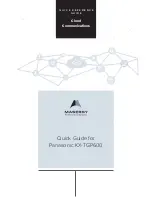
Quality of Service guidelines
332 Avaya Application Solutions IP Telephony Deployment Guide
Administration commands for Example 3
If any of the endpoints are incapable of tagging, the “dscp 46” can be removed from access list
101. Then any traffic between the two IP Telephony subnetworks, regardless of the tag, is in the
class “VoIP.”
Table 79: Administration commands for Example 3
Command
Meaning
1.access-list 101 permit
ip 192.168.1.0
0.0.0.255
192.168.2.0 0.0.0.255
dscp 46
Left router
2.access-list 101 permit
ip 192.168.2.0
0.0.0.255 192.168.1.0
0.0.0.255 dscp 46
Right router
The “access list 101...” permits any IP traffic
that is tagged with DSCP 46 between the two
VoIP subnets. There is an implicit deny any at
the end of this access list
3.class-map match-any
VoIP
Create a class map called “VoIP.”
4.match access-group 101
Only packets matching access list 101 are in
the class VoIP; this is more restrictive than
matching any packet with DSCP 46 or 34.
5.policy-map voipQoS
Create a class map called “VoIP.”
6.class VoIP priority
768
Give strict priority to packets in the class
“VoIP” on up to 768k of this WAN link.
7.class class-default
fair-queue
Put everything else in the default class and
transmit it out the default queue in a fair
queue fashion.
8.random-detect
dscp-based
If the default queue starts to get full,
randomly discard packets in this queue
based on DSCP (lower values get discarded
first).
9.interface Serial0
description T1 ip
address 172.16.0.1
service-policy output
voipQoS
Apply the “voipQoS” policy outbound on this
interface.
Summary of Contents for Application Solutions
Page 1: ...Avaya Application Solutions IP Telephony Deployment Guide 555 245 600 Issue 3 4 1 June 2005 ...
Page 20: ...About This Book 20 Avaya Application Solutions IP Telephony Deployment Guide ...
Page 21: ...Issue 3 4 1 June 2005 21 Section 1 Avaya Application Solutions product guide ...
Page 22: ...22 Avaya Application Solutions IP Telephony Deployment Guide ...
Page 106: ...Call processing 106 Avaya Application Solutions IP Telephony Deployment Guide ...
Page 124: ...Avaya LAN switching products 124 Avaya Application Solutions IP Telephony Deployment Guide ...
Page 139: ...Issue 3 4 1 June 2005 139 Section 2 Deploying IP Telephony ...
Page 140: ...140 Avaya Application Solutions IP Telephony Deployment Guide ...
Page 186: ...Traffic engineering 186 Avaya Application Solutions IP Telephony Deployment Guide ...
Page 204: ...Security 204 Avaya Application Solutions IP Telephony Deployment Guide ...
Page 228: ...Avaya Integrated Management 228 Avaya Application Solutions IP Telephony Deployment Guide ...
Page 274: ...Reliability and Recovery 274 Avaya Application Solutions IP Telephony Deployment Guide ...
Page 275: ...Issue 3 4 1 June 2005 275 Section 3 Getting the IP network ready for telephony ...
Page 276: ...276 Avaya Application Solutions IP Telephony Deployment Guide ...
Page 356: ...Network recovery 356 Avaya Application Solutions IP Telephony Deployment Guide ...
Page 366: ...Network assessment offer 366 Avaya Application Solutions IP Telephony Deployment Guide ...
Page 367: ...Issue 3 4 1 June 2005 367 Appendixes ...
Page 368: ...Appendixes 368 Avaya Application Solutions IP Telephony Deployment Guide ...
Page 394: ...Access list 394 Avaya Application Solutions IP Telephony Deployment Guide ...
Page 414: ...DHCP TFTP 414 Avaya Application Solutions IP Telephony Deployment Guide ...
















































